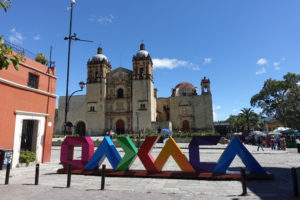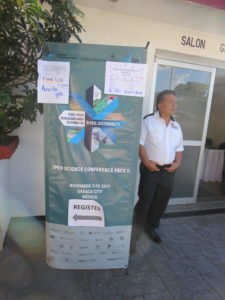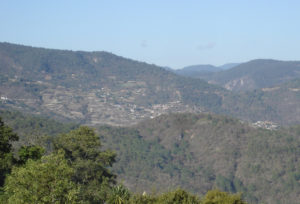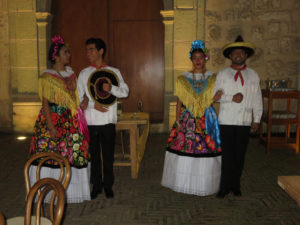
By Catherine Tucker
— In early November, I had the privilege of attending the second conference of the Program on Ecosystem Change and Society (PECSii) in Oaxaca City, Mexico. For many reasons, the conference ranked among the best I have ever attended. The setting itself encompasses many of the challenges facing mountains and other social-ecological systems: impacts from climate change, economic transformations, environmental problems and sociopolitical conundrums, here rooted in the legacies of Zapotec, MIxe, Mixtec and Imperial Spanish civilizations as well as more recent human societies. PECSii participants came from around the world to present research and explore ideas that highlighted social-ecological predicaments and possibilities for constructive transformation.

Sign for the PECSii Meeting in Oaxaca.
The organizers used creative approaches for each of the components of the program. We knew we were in for a unique conference when the first activity on the opening day was an earthquake drill. Instead of getting comfortable in our seats, we found ourselves walking out of the meeting hall and gathering outdoors away from the building. In the wake of the traumatic earthquakes that hit southern and central Mexico just weeks before the conference, we found it somehow comforting to enact a safety lesson together in the face of uncertain peril. Thereafter mornings opened with a pair of exciting keynotes, delivered by experts including Sandra Diaz, Victor Galvez, Fikret Berkes, Xavier Basurto, Julianna Mercon and Elena Benentt. The keynotes were kept succinct to allow for a conversation with the speakers and questions from the audience. The subsequent activities ranged from panels with short presentations or speed talks to “innovative and immersive” sessions, flash workshops, and video and poster presentations. Attendees thronged to sessions with alluring titles such as “The Sustainabiity Hype: Climate Change, Nanites, and Nuclear Zombies,” “Science for Transformation and the Transformation of Science,” “Tackling Complexity by Increasing Complexity,” “Towards Realistic, Plausible and Positive Futures for the Planet, “ and “Chefs and Cooks as Change-Makers in the Food System,” among many others. In the panel sessions, presenters spoke succinctly with 10 minute slots, then the audience and presenters broke into small groups to share experiences and perspectives on central issues and controversies.
Unlike most conferences, I had no chance to get drowsy, because the audience was constantly engaged in discussions. A session on “Transformation in the Anthropocene” asked groups to discuss presentations and share findings. Here, mountain systems received particular attention due to their vulnerability to climate change, and we discussed transdisciplinary approaches to foster adaptation and resilience. In immersive and innovative sessions, we explored challenging problems and brain-stormed possible solutions. In one instance, the organizer assigned each group a social-ecological conundrum and asked for possible solutions, in another, participants played an experimental board game of Mexico City’s social-hydrological system, developed as a modeling and communication tool. Even the poster sessions offered a twist: posters were grouped into sets of 4-6 posters with similar themes, and presenters had to give 3 minute summaries of their work to interested spectators. Facilitators then sparked discussions among the presenters and the audience.
The exchanges continued throughout each day, nourished by coffee breaks generously provisioned with Mexican appetizers and traditional treats, and lunch buffets that offered a sweeping introduction to Oaxaca’s culinary delights — moles, salsas, succulent meats, rich soups, grilled vegetables, fresh salads, tropical fruits and tempting desserts. In the evenings, we walked the streets of Oaxaca City’s colonial center, dotted with venerable churches, historical monuments and museums, parks, artisan shops and numerous restaurants – some of which could merit a Michelin star. On the horizon we could see the shadows of Oaxaca’s imperturbable mountains, sharp black edges outlined against the rising stars.

Sierra Juarez View
The closing ceremony honored Oaxaca’s cultural diversity with a variety of food and beverages, but the highlight was the program of traditional dances presented by troupes representing several of Oaxaca’s indigenous groups, including Mixe, Mixtec and Zapotec communities. These cultural groups have survived and thrived in Oaxaca’s mountains and valleys despite conquest, economic crises, and ongoing environmental and social tragedies, and yet they maintain their cultural integrity and vitality. In the end, the PECSii conference offered glimmers of hope, reflected in the grace and stamina of the Oaxacan dancers. I left the conference thinking that we still have a chance to spark transformations toward a more resilient world.

Isthmus Zapotec Dance

